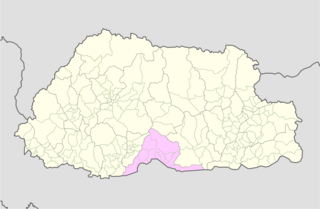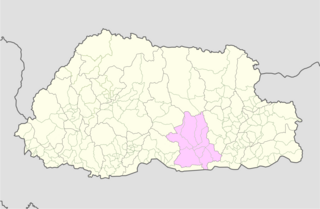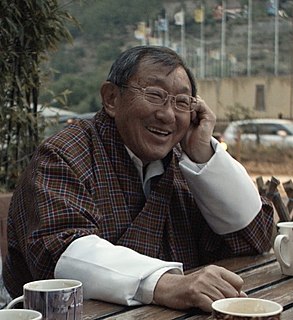
Jigme Singye Wangchuck is a member of the House of Wangchuck who was the king of Bhutan from 1972 until his abdication in favour of his eldest son, Jigme Khesar Namgyel Wangchuck, in 2006.

Wangdue Phodrang District is a dzongkhag (district) of central Bhutan. This is also the name of the dzong which dominates the district, and the name of the small market town outside the gates of the dzong—it is the capital of Wangdue Phodrang District). The name is said to have been given by the Shabdrung Ngawang Namgyal who was searching for the best location for a dzong to prevent incursions from the south. The word "wangdue" means unification of Country, and "Phodrang" means Palace in Dzongkha.

Samdrup Jongkhar District is one of the 20 dzongkhags (districts) comprising Bhutan. The dominant languages of the district are Tshangla (Sharchopkha) in the north and west, and Nepali in the east. It covers a total area of 1878 sq km. Samdrup dzongkhag comprises two dungkhags: Jhomotsangkha and Samdrupchhoeling, and 11 gewogs.

Sarpang District is one of the 20 dzongkhags (districts) comprising Bhutan. Sarpang covers a total area of 1,946 sq km and stretches from Lhamoizhingkha in West Bhutan to Manas National Park in the east. Sarpang Dzongkhag is divided into one dungkhag, Gelephu, and 12 gewogs.

Zhemgang District, is one of the 20 dzongkhags (districts) comprising Bhutan. It is bordered by Sarpang, Trongsa, Bumthang, Mongar and Samdrup Jongkhar Districts, and borders Assam in India to the south. Administrative center of the district is Zhemgang.
Articles related to Bhutan include:

Trongsa District is one of the districts of Bhutan. It is the most central district of Bhutan and the geographic centre of Bhutan is located within it at Trongsa Dzong.

The Eastern Himalayan broadleaf forests is a temperate broadleaf forest ecoregion found in the middle elevations of the eastern Himalayas, including parts of Nepal, India, and Bhutan. These forests have an outstanding richness of wildlife.

The Manas River is a transboundary river in the Himalayan foothills between southern Bhutan and India. It is the largest river system of Bhutan, among its four major river systems; the other three are Amo Chu or Torsa river, Wong Chu or Raidak, Puna Tshang Chu or Sankosh. It is met by three other major streams before it again debouches into India in western Assam. The total length of the river is 400 kilometres (250 mi), flows through Tibet, China for 24 km (15 mi), flows in Bhutan for 272 kilometres (169 mi) and then flows through Assam for 104 kilometres (65 mi) before it joins the mighty Brahmaputra River at Jogighopa. Another major tributary of the Manas, the Aie River joins it in Assam at Bangpari.

The Eastern Himalayan alpine shrub and meadows is a montane grasslands and shrublands ecoregion of Bhutan, China, India, Myanmar, and Nepal, which lies between the tree line and snow line in the eastern portion of the Himalaya Range.

The Eastern Himalayan subalpine conifer forests is a temperate coniferous forests ecoregion which is found in the middle and upper elevations of the eastern Middle Himalayas, in western Nepal, Bhutan, and northern Indian states including Arunachal Pradesh and Sikkim.

Jigme Singye Wangchuck National Park covers an area of 1,730 square kilometres (670 sq mi) in central Bhutan. It protects a large area of the Black Mountains, a sub−range of the Himalayan Range System.

The Phibsoo Wildlife Sanctuary is the second-smallest national park in Bhutan, covering 268.93 square kilometres (103.83 sq mi) in western Sarpang District and southeastern Dagana District along the border with West Bengal. It is connected to Jigme Singye Wangchuck National Park and Royal Manas National Park via a "biological corridor" that crosses a national highway. Its elevations range from 200 metres (660 ft) to 1,600 metres (5,200 ft). It is separated from the border with India by two rivers, the Sunkosh River to the west and the Sanathang River to the east. The park is recovering from the scars of the ’90s. In those years, when the country had internal problems with the militia, that is why the park only came to life in 2009.

Royal Manas National Park is Bhutan's oldest national park, and the Royal government considers it the "conservation showpiece of the Kingdom" and a "genetic depository" for valuable plants. It has an area of 1,057 square kilometres (408 sq mi) and covers eastern Sarpang District, the western half of Zhemgang District, and western Pemagatshel District.

The Jigme Khesar Strict Nature Reserve in Bhutan covers 609.51 square kilometres (235.33 sq mi) in Haa District, occupying most of its area. Founded when other national parks in 1993 by decision of the royal government. It borders Sikkim and Tibet to the west and is connected to Jigme Dorji National Park via a "biological corridor." Jigme Khesar contains the westernmost temperate forests of Bhutan, from broadleaf forests to alpine meadows and the small lakes of Sinchulungpa, at altitudes ranging from 1,400 metres (4,600 ft) to 4,800 metres (15,700 ft). Like Phibsoo Wildlife Sanctuary, Jigme Khesar has no resident human population.

Wangchuck Centennial National Park in northern Bhutan is the kingdom's largest national park, spanning 4,914 square kilometres (1,897 sq mi) over five districts, occupying significant portions of northern Bumthang, Lhuntse, and Wangdue Phodrang Districts. It borders Tibet to the north and is bound by tributaries of the Wong Chhu (Raidāk) basin to the west. Wangchuck Centennial directly abuts Jigme Dorji National Park, Bumdeling Wildlife Sanctuary, and Phrumsengla National Park in northern Bhutan, and is further connected to Jigme Singye Wangchuck National Park in central Bhutan via biological corridors. Thus, most of northern Bhutan is part of these protected areas.

The Royal Botanical Park, Lampelri is the first botanical park in Bhutan and forms the backdrop of the Dochula Pass. The park forms a biological corridor of 47 square miles (120 km2) between the Jigme Singye Wangchuck National Park and the Jigme Dorji Wangchuck National Park and has a popular botanical garden within it which is spread over an area of 125 acres (51 ha). This is planted with 46 species of rhododendron of which 18 species are native to the park while the other 26 species are brought from other regions of Bhutan and planted here. These bloom during mid March to early August. The botanical garden of the park has within its limits the 108 stupas (chortens) at the Dochula Pass (3100m). The park was formally declared open in June 2008 to mark the anniversary of the Coronation of King Jigme Kesar Namgyel Wangchuk and centenary of Bhutan's monarchic rule. Mr. Phenden Gyamtsho is the Park Manager, heading a technical team of young, humble and hardworking staff. The park facility centre opens from 9am to 5pm in summer and from 9am to 4pm in winter. The park seriously embarks on waste management advocacy programs to educate the general public. Garbage IN and garbage OUT policy is being emphasised.

Dasho Paljor Jigme Dorji, commonly known as Dasho Benji, is a Bhutanese environmentalist, judge and diplomat.




















